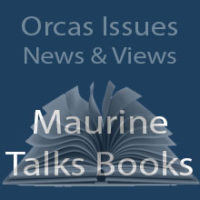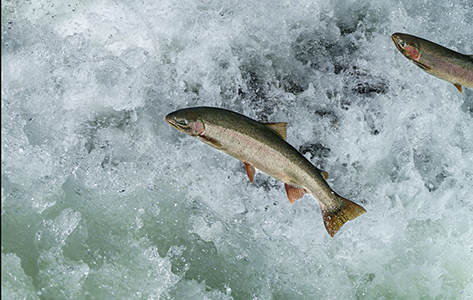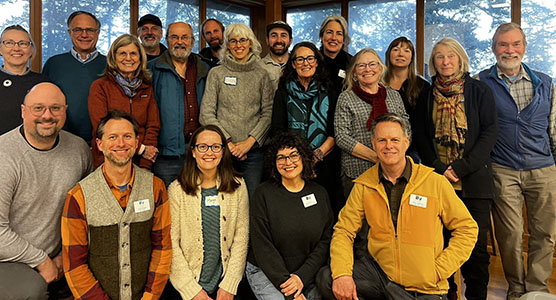— from Maurine Bennett —
After the over-predictions concerning last weekend’s Pacific Northwest storms, and my obsession with reading all the charts, graphs, newspapers and blogs about it, I realized I have become a weather nerd. Some of the most engaging reads have been about weather, too. (My blog about Hurricane Katrina from September 2015 was one of my favorites to write) And, the topic of weather has reached a new level with the fear, activism and denial around climate change. More and more writers are now joining the spirited conversations.
Isaac’s Storm, by Erik Larson
 My favorite of all Seattle author Erik Larson’s books is one that is lesser-known. (I must admit to abandoning that best selling Devil in the White City after 100 pages, as it was too creepy for my taste!) In September of 1900, the town of Galveston, Texas found itself almost completely destroyed by a huge hurricane came on suddenly and killed 6,000 people. It remains the greatest natural disaster in American history, one that could have taken fewer lives if a local meteorologist named Isaac Cline had taken its prediction more seriously early on. His miscalculations and arrogance make for a particularly riveting story, about the disaster that cost him much more than his beloved home. The losses of this storm did propel the science of hurricane and storm behavior ahead many decades, but at a huge cost to the community of Galveston and Cline’s family. Personally, I think this story is Larson at his best!
My favorite of all Seattle author Erik Larson’s books is one that is lesser-known. (I must admit to abandoning that best selling Devil in the White City after 100 pages, as it was too creepy for my taste!) In September of 1900, the town of Galveston, Texas found itself almost completely destroyed by a huge hurricane came on suddenly and killed 6,000 people. It remains the greatest natural disaster in American history, one that could have taken fewer lives if a local meteorologist named Isaac Cline had taken its prediction more seriously early on. His miscalculations and arrogance make for a particularly riveting story, about the disaster that cost him much more than his beloved home. The losses of this storm did propel the science of hurricane and storm behavior ahead many decades, but at a huge cost to the community of Galveston and Cline’s family. Personally, I think this story is Larson at his best!
Thunder & Lightning, by Lauren Redniss
Of all the books that showed up last fall in time for holiday giving, this is the one I  most wanted under my tree! Redniss, a quirky yet superb graphic artist was also the author of Radioactive: Marie and Pierre Curie, a Tale of Love and Fallout, which was a finalist for the National Book Award in 2011. She also teaches at the Parsons School of Design. This book demands attention to detail and defies portability–that is, I did not carry it in the car to read bits and pieces here and there. Instead, it delivers excellence and many insights for those willing to invest the time; I was mesmerized and spent a week reading and studying it at home at my desk. In the end, her text and art work left a magical impression on me–this is how human beings coexist with nature, something absolutely greater than ourselves, that is changing quickly and often violently. We have a sometimes difficult choice–to fight it or learn to coexist.
most wanted under my tree! Redniss, a quirky yet superb graphic artist was also the author of Radioactive: Marie and Pierre Curie, a Tale of Love and Fallout, which was a finalist for the National Book Award in 2011. She also teaches at the Parsons School of Design. This book demands attention to detail and defies portability–that is, I did not carry it in the car to read bits and pieces here and there. Instead, it delivers excellence and many insights for those willing to invest the time; I was mesmerized and spent a week reading and studying it at home at my desk. In the end, her text and art work left a magical impression on me–this is how human beings coexist with nature, something absolutely greater than ourselves, that is changing quickly and often violently. We have a sometimes difficult choice–to fight it or learn to coexist.
Rain, by Cynthia Barnett
 Why would someone who lives on the western side of the mountains in the Pacific Northwest want to read anything about rain? Because there are so many fascinating facts about it, and stories of human efforts to change nature to secure more rain or less, depending on circumstances. The places that Barnett takes us in her efforts to thoroughly cover the topic are diverse and delightful. There are anecdotes about England’s reluctance to embrace new contraptions like the umbrella, then later on their raging enthusiasm (particularly for black). And stories of the challenges of modern manufacturers to produce waterproof rain gear. She takes us to India to explore a perfume made from the mud of the monsoon rains, and to Scotland to tell the story of the ubiquitous Macintosh. She explores rain from all angles: science, art, literature, politics, history and music. And it surprised me that I was not at all bored by such a thorough examination!
Why would someone who lives on the western side of the mountains in the Pacific Northwest want to read anything about rain? Because there are so many fascinating facts about it, and stories of human efforts to change nature to secure more rain or less, depending on circumstances. The places that Barnett takes us in her efforts to thoroughly cover the topic are diverse and delightful. There are anecdotes about England’s reluctance to embrace new contraptions like the umbrella, then later on their raging enthusiasm (particularly for black). And stories of the challenges of modern manufacturers to produce waterproof rain gear. She takes us to India to explore a perfume made from the mud of the monsoon rains, and to Scotland to tell the story of the ubiquitous Macintosh. She explores rain from all angles: science, art, literature, politics, history and music. And it surprised me that I was not at all bored by such a thorough examination!
The Wave, by Susan Casey
Nearly every book that even mentions surfing has my immediate attention and extra patience. Casey, much like the writer mentioned above who explored rain, takes on the sea, and  specifically mega waves. Unlike the book Rain, however, this account follows a group of surfers headed by mega-surfer Laird Hamilton who chase around the world looking for at least 100′ waves in an attempt to surf them. Juxtaposed are studies by scientists and others to as to why such waves exist and how they are formed. Over 200 large, ocean-going ships have disappeared in the past 20 years, and until recently, the idea of 100′ or more rogue waves was an unproven theory. Only after an oil rig in the North Sea was nearly destroyed by such a wave were scientists able to finally prove their existence. Casey’s book, to be honest, is more about surfer Hamilton and the big wave surfers than it is about the science of waves. However, that is not at all negative in my world, and makes the book all the more readable.
specifically mega waves. Unlike the book Rain, however, this account follows a group of surfers headed by mega-surfer Laird Hamilton who chase around the world looking for at least 100′ waves in an attempt to surf them. Juxtaposed are studies by scientists and others to as to why such waves exist and how they are formed. Over 200 large, ocean-going ships have disappeared in the past 20 years, and until recently, the idea of 100′ or more rogue waves was an unproven theory. Only after an oil rig in the North Sea was nearly destroyed by such a wave were scientists able to finally prove their existence. Casey’s book, to be honest, is more about surfer Hamilton and the big wave surfers than it is about the science of waves. However, that is not at all negative in my world, and makes the book all the more readable.
The Children’s Blizzard, by David Laskin
 When I spotted this book by Seattle writer David Laskin, I was thrilled, as I loved his book The Family (Winner of the Washington State Book Award 2104) so much. Otherwise, I would not have tackled this heartbreaking story of a historic blizzard in January 1888 which blanketed the Dakota Territory that killed over 200 children and adults. It is the kind of historical documentary that Laskin does so well: part history, part family saga, weather analysis and medical information. At times, it was painful to read, but I learned more about weather, remembering a story my Dad once told me about how he almost died during a blizzard in 1922 while logging with his Dad in the Minnesota woods. For some, there may be too much detail in the telling of this story, such as meteorological data and the histories of Scandinavian immigrants who came to this country seeking more space and financial independence, but for me it was absolutely riveting. I read anything Laskin writes.
When I spotted this book by Seattle writer David Laskin, I was thrilled, as I loved his book The Family (Winner of the Washington State Book Award 2104) so much. Otherwise, I would not have tackled this heartbreaking story of a historic blizzard in January 1888 which blanketed the Dakota Territory that killed over 200 children and adults. It is the kind of historical documentary that Laskin does so well: part history, part family saga, weather analysis and medical information. At times, it was painful to read, but I learned more about weather, remembering a story my Dad once told me about how he almost died during a blizzard in 1922 while logging with his Dad in the Minnesota woods. For some, there may be too much detail in the telling of this story, such as meteorological data and the histories of Scandinavian immigrants who came to this country seeking more space and financial independence, but for me it was absolutely riveting. I read anything Laskin writes.
The Perfect Storm, by Sebastian Junger
A classic from almost the first day it was published, Junger (author of such best sellers asA Death in Belmont, and Tribe), follows the fate of the crew of fishing vessel Andrea Gail, from Gloucester, Massachusetts, which was fishing for swordfish off the coast of Nova Scotia in the fall of 1991. While the boat and crew were lost during one of the worst storms to suddenly hit the Atlantic seaboard, Junger vividly recreates what he thought may have happened by using accounts from various meteorologists, other fishermen and family members. Both life on board a fishing boat, and the science of storms are richly described, and the tragedy of the lost lives and their families are given even billing. The book read, to me, better than most of the best fiction thrillers I have loved, and pays a lasting tribute (even better than the memorial statue) to the loss of the lives of the six young fishermen. The book was so suspenseful that I doubt I would have the stomach for the movie version, which I heard was also amazing. If you are feeling bored with politics, pick up this book!
asA Death in Belmont, and Tribe), follows the fate of the crew of fishing vessel Andrea Gail, from Gloucester, Massachusetts, which was fishing for swordfish off the coast of Nova Scotia in the fall of 1991. While the boat and crew were lost during one of the worst storms to suddenly hit the Atlantic seaboard, Junger vividly recreates what he thought may have happened by using accounts from various meteorologists, other fishermen and family members. Both life on board a fishing boat, and the science of storms are richly described, and the tragedy of the lost lives and their families are given even billing. The book read, to me, better than most of the best fiction thrillers I have loved, and pays a lasting tribute (even better than the memorial statue) to the loss of the lives of the six young fishermen. The book was so suspenseful that I doubt I would have the stomach for the movie version, which I heard was also amazing. If you are feeling bored with politics, pick up this book!
The Weather of the Pacific Northwest, by Cliff Mass
 Mass is a character in his own right, as anyone who follows his weather blog will attest. A professor of Atmospheric Sciences at the University of Washington, his understanding of the challenges of forecasting and explaining weather in the Northwest corner of the country is probably unmatched. (Many mountains, the Pacific Ocean, the Straits of Juan de Fuca and assorted other geographical oddities abound). His weather blog is read by thousands, but one is almost as likely to read about the Seattle School Board elections as the coming storms. The book, published in 2008, is my go-to guide for all things weather related. I can open any page and read a section about snow on the Cascade Crest Trail, for example, and not have to read the chapters before or after. For those who are curious about weather anywhere, it is a great resource, endlessly fascinating to me and some of my nerdy science friends. And many others, obviously, as the bookstores I frequently work in keep selling and selling this volume, even eight years later.
Mass is a character in his own right, as anyone who follows his weather blog will attest. A professor of Atmospheric Sciences at the University of Washington, his understanding of the challenges of forecasting and explaining weather in the Northwest corner of the country is probably unmatched. (Many mountains, the Pacific Ocean, the Straits of Juan de Fuca and assorted other geographical oddities abound). His weather blog is read by thousands, but one is almost as likely to read about the Seattle School Board elections as the coming storms. The book, published in 2008, is my go-to guide for all things weather related. I can open any page and read a section about snow on the Cascade Crest Trail, for example, and not have to read the chapters before or after. For those who are curious about weather anywhere, it is a great resource, endlessly fascinating to me and some of my nerdy science friends. And many others, obviously, as the bookstores I frequently work in keep selling and selling this volume, even eight years later.
**If you are reading theOrcasonian for free, thank your fellow islanders. If you would like to support theOrcasonian CLICK HERE to set your modestly-priced, voluntary subscription. Otherwise, no worries; we’re happy to share with you.**








